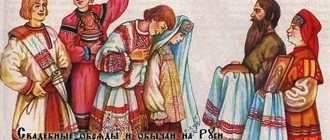Matchmaking, engagement, conspiracy - Marriage proposal.
In the old days, matchmakers were people who were entrusted with the responsible mission of arranging a wedding. Professional matchmakers helped find a good bride or groom, and sometimes one of the relatives or even the father himself acted as a matchmaker.
Usually, matchmakers from the groom came to the bride’s house and negotiated with her father; if he gave the go-ahead, then the matchmakers were invited to the bride’s show to get to know the bride personally and evaluate her.
When everything went well, a conspiracy was made - the final agreement on the wedding and the amount of the dowry. After this, a celebration was held - an engagement party. At it, the decision of two families to become related was told to all honest people and refreshments were distributed. In the village, the engagement was a rather modest dinner, and in noble estates it was a ball that began with a waltz of the bride and groom.
Instead of matchmaking, girls wait for a marriage proposal from their lover. Preferably in a romantic setting with flowers and a ring.
Now the matchmaking ritual has become a relic of the past, although the parents of young people are still called matchmakers. Instead of matchmaking, girls wait for a marriage proposal from their lover. Preferably in a romantic setting with flowers and a ring.
If earlier matchmakers had to impress the bride's parents, now the groom must conquer his bride himself. Some men make very original proposals in order to finally win the heart of their beloved, to move her to tears - in such a situation she definitely cannot refuse.
If the girl answers “yes,” then this event is also called an engagement. It can also be considered a conspiracy, because today a girl and a young man decide to get married independently, without the participation of their parents. From the day they propose, modern lovers change their status on social networks from “in a relationship” to “engaged.”
Ancient Rus' (chastity!)
Woman!.. Guardian of the home, keeper of good relationships, family values, Love and Fidelity!
The main color of beauty and joy in Russia was red, hence the expression: “red maiden”
.
In Rus', a girl’s virginity was highly valued! In 953, Princess Olga issued a decree: on the theme of a sex wedding, it sounded like this :
from now on, monetary or in-kind compensation has now been introduced for virginity!
After this, virginity truly became respected and valuable, while virginity was considered a shame.
By the way! Some time later in 967, Svyatoslav (Olga’s son) issued a decree, which was stated as follows
:
“from now on, deflowering is the direct responsibility of the husband and his dignity.”
In Russia there were the following traditions: after the first wedding night, the guests were brought out a bloody sheet or shirt of the newlywed. Sometimes it was replaced with a broom tied with a red ribbon. In some regions, there was such a tradition: if the newlywed turned out to be a virgin, they smashed the dishes to celebrate!
Women who did not marry as virgins, as a rule, faced a sad future: in their husband’s family they were subjected to all sorts of humiliations and had to do the most difficult and dirty work. In addition, the husband often beat his wife, including whip just for sin (no comments!). If after the wedding a child was born, the husband had every reason to suspect that the child was not his, and most often it happened like this: not only the wife got it, but the child got the same, which I think is not right, the children had nothing to do with it, but It’s unlikely that this was understood before!?
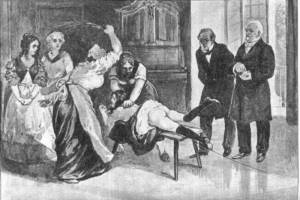
If a wife was accused of adultery, the so-called most shameful punishments could be applied to her . One of them was cutting hair
, which was generally considered a shameful disgrace for a woman in Rus'!
Braided braids were greatly appreciated and admired!
Unmarried girls wore their braids loose over their shoulders, while married girls wore them with a headband around their heads. If the husband found out about the betrayal, he had every right to wrap her braids around his hand and cut them off, after which she was afraid to appear in public; this was considered a shame.
In some villages and hamlets, adulterous wives were led through the streets stripped naked with wreaths of burrs on their heads, and passers-by threw stones at them...
Widows-harlots who had bewitched other people's husbands from the family were also punished. A deceived wife could break the windows in the house of the homewrecker, cut off her braids and even set the house on fire.
And in the Cossack environment they went even further in this matter: for treason, a wife was tied to a horse’s tail and the horse was allowed across the field, or she was completely undressed and tied to a tree, leaving it to be devoured by insects! (creepy).
Even among the “elite” of the times of Ivan the Terrible, virginity was highly valued, and virginity was not punished! You can use the Tsar himself as an example! In November 1573, Tsar Ivan the Terrible married Maria Dolgoruky for the fifth time. She turned out to be not a virgin! The next morning the tsar ordered to go to Alexandrovskaya Sloboda. There, by order of Ivan the Terrible, the sinner was thrown into a hole cut in the ice, where she drowned.
The Tsar did not expect such a deception and did not forgive him, of course harshly, but it was a fight for morality!
And we came to the conclusion that the dovecote is on the screen!)))) We took a wrong turn...

Chastity is the purity of relationships! And cleanliness is the key to health!
Cleanliness is the best beauty!
From a pure heart - The eyes see purely!
Before all this, what I wrote above was deprived of virginity by the Magi (including not by traditional methods). BUT that was before and this is... a completely different story!
Write in the comments: is it worth further writing on similar topics about the traditions of ancient Rus'?
LIKE! if you liked the article!
Bride's viewing - Meeting the parents.
The bride's viewing today can be compared with meeting her parents. It does not always occur after a marriage proposal, often even before it. Nevertheless, even now this is a very important moment in the life of every young couple. If a man decides to introduce his beloved to his parents, then he takes the relationship very seriously. The same can be said about the girl.

Each of the couple is usually nervous before the first meeting with the parents of a loved one, prepares for it and wants to make a good impression. Girls are more worried about meeting the mother of their loved one, and men are more worried about meeting her father. How parents evaluate their son or daughter's other half can greatly influence the couple's relationship in the future. If the acquaintance goes well, then the likelihood that the newlyweds will get married greatly increases.
How did they choose brides in Rus'?
Beauty and health are valuable at all times. Ancient Rus' is no exception. In the old days, there were special standards by which future wives were selected, and not every girl was considered a potential bride. So who did the suitors not favor and bypass the tenth road? Let's try to figure it out.
Matchmakers have traditionally been the main "driving force" of marriage. They always knew exactly where there was a girl of marriageable age in the village, what kind of health she was, what she had in her heart and what she was like in the household. They closely monitored how hardworking the girl was, assessed her appearance and obedience to her parents. The age of the applicant and special features, as they say, “for the future” were also important.
Skinny people are not valuable
Skinny people were openly disliked in Rus'. The grooms did not favor them. Why? Everything is very simple - an excessively slender young woman could be “barren”, that is, infertile. Even modern medicine admits that thinness does not contribute to conception and childbearing.
It was believed that the “Yalitsa” would not be able to get pregnant. And if a miracle does happen, there is a huge risk of stillbirth or loss of the child. In addition, these girls, as a rule, have a narrow pelvis. In the old days, such women in labor often could not give birth and died in childbirth. In most cases, the child also died.
Thinness was considered painful. Suffice it to recall the canvases with images of rosy-cheeked peasant women bursting with health. Only such girls were considered ideal. After all, it fell to the woman’s lot not only to weave wreaths across the fields, but also to carry the household chores. And these are numerous children, a garden, a house. In a word, an incredible amount of energy and strength was required. An excessively thin girl would not have been able to cope with this.
There was also an opinion that if a bride is too thin, her family is not rich. Wealthy peasants wanted to see only someone equal in status as a mate for their heir. Freeloaders were not tolerated and were openly expelled from the world. In other words, thinness was recognized as a kind of sign of degeneration, a fatal flaw. The prospects for such a girl to get married were ghostly few.
Chastity
No matter what fiction says, the issue of virginity among peasants was not too acute and did not particularly worry the potential groom and relatives. On the contrary, a woman with a child was valued much more than one who had not yet known the happiness of motherhood. After all, this meant that the bride was healthy and childbearing. Consequently, she will give her future husband heirs without any problems.
Appearance
The issue of appearance for a girl of marriageable age was one of the most pressing. Even a small scratch could ruin the matchmaking process. The same applied to a common runny nose or a barely noticeable sore. The matchmakers noticed such small details that no one else saw. Only a rich dowry could level out the above situation.
The presence of some kind of illness or (God forbid!) injury in a girl forever transferred her to the category of “defective”. The question of marriage was removed for her. Birthmarks on the body were also considered a sign of hidden illness.
On the eve of the wedding, brides were vigilantly guarded, even the smallest scratches were healed and even fed only from their parents' hands. After all, at all times there were many well-wishers who dreamed of disrupting the wedding. A similar situation took place in the history of Russia. Tsar Mikhail Fedorovich's desire to marry Maria, a poor noblewoman, encountered parental opposition.
The Queen Mother disliked her future daughter-in-law, and the girl suddenly fell ill. The reason was revealed later - cakes with spoiled cream, slipped by the “loving mother-in-law.” Maria recovered, her body was strong. However, the engagement had to be called off. This is how women’s cunning influenced the lives of young people and, perhaps, the fate of Rus'.
Age limit
The age of 12-15 years was considered ideal for marriage. At the same time, 12 years old is for girls, 15 years old is for boys. An approximately similar age range (2-3 years) still exists. They say that the ideal difference between spouses is exactly 2-3 years. This opinion is certainly controversial, but has a right to exist.
If a girl did not get married before the age of 18, she was considered “too old” and risked remaining single forever. There was a generally accepted opinion that such brides were somehow “abnormal”; matchmakers were no longer interested in them. After all, this was the only way to “explain” the reluctance of the suitors to connect their fate with them. Who would want to take “defective goods”?
Ancient traditions are very interesting. Many of them still exist today. It is our right to agree with them or not. After all, happiness has no age or appearance. It is in the soul.
Engagement - Time to prepare for the wedding.
Engagement used to be called not only the celebration of the newlyweds’ decision to get married, but also the entire time that passed before the wedding. The engagement could last from several months to several years, and sometimes - this happened - she was upset. That is, the wedding was canceled for some compelling reason.
Nowadays, couples prepare for their wedding at different times, since everyone has a different opinion about what the celebration should be like. Some organize a modest celebration with dinner, while others organize a bright celebration, thought out to the smallest detail. In the first case, a month is enough for preparation, and in the second, the wedding will be organized from six months to one and a half years.
When to get married nowadays
Most modern young people are freed from the need to marry at the behest of their parents at an early age, although not everywhere. Representatives of some cultures and nationalities still follow centuries-old traditions, getting married as early as possible.
In our society, early marriages are rather discouraged than encouraged. If we talk about the preferences of modern girls, then, according to statistics and surveys, they prefer to get married at the age of about 25 years. In a fairly large percentage of cases, the decision to marry is influenced by Western cultural trends and socio-economic factors.
The situation is somewhat different for men. There is an opinion that it is difficult to bring a man to the registry office because he is afraid of marriage. This statement is not entirely true. According to psychologists' studies, men only experience fear of marriage at a certain age.
According to the same studies, men consider the optimal age to start a family to be after 27 years of age. This is due to the fact that in society there is an idea of the ideal model of behavior of a true man, according to which, before getting married, he must prepare a material base and realize himself at work.
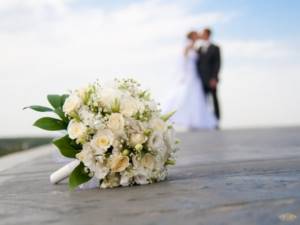
Another interesting result of the research was the confirmation of the popular belief that there should be some age difference between spouses, but not too much: the largest number of divorces occurs among those who were married the same age. At the same time, families in which the age of the spouses at the time of marriage was closer to 30 years are happier and the number of divorces is significantly lower.
However, there is no perfect recipe for a happy marriage. You can get married at 18 and live happily ever after, or perhaps a different development of events. Be that as it may, the main thing is to perform this act consciously, taking responsibility for the decision made. An important point is mutual respect and understanding. Well, and love, of course!
Hen-party.
Modern bachelorette parties are radically different from those that took place in the old days. Today it is a bright, cheerful party where the bridesmaids congratulate her (often jokingly), rejoice at her happiness, and the bride herself enjoys their attention. Of course, there is a reason for joy - the bride is marrying her beloved, her fate is arranged as she wants, one can only congratulate her on this. And the note of sadness associated with saying goodbye to a “single” life today is rather symbolic.
In the old days, things weren't so fun. Despite the fact that a wedding was an important and positive event in the life of any woman, there was also a big fly in the ointment.

Firstly, a very young and inexperienced girl was taken from her parents' home to someone else's family. Despite all the pre-wedding events, it was absolutely unknown how she would be received in this family, whether she would find a common language with her husband’s relatives and how successful her life would be. Secondly, before the wedding, the bride might not have seen or known her groom at all. That is, after the wedding, she had to enter into a close relationship with a complete stranger. So the girl herself and all her relatives were very worried.
The bride's friends and all her relatives gathered for the bachelorette party; they gave her gifts and sang plaintive songs. The bride was supposed to cry. It was believed that if she shed tears before the wedding, her marriage would be successful.
We create communication
To remain unmarried was the worst misfortune for a girl in Rus'. In the old days, the choice of a bride was approached very carefully, and getting married was much more difficult than it is today. In addition to external data, there were many criteria by which grooms selected their chosen one. To be an eligible bride, you had to have many skills, although even this did not guarantee a successful marriage.
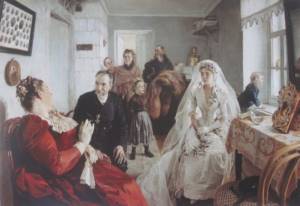
When they talk about Russian girls, many people imagine a plump, strong girl with a blush on her cheeks. This is how we often see them in ancient paintings and photographs. Yes, the hard work on the land, which most peasants did, was beyond the power of the pampered and weak.
When the time came to get married, men tried to choose a stout girl as a wife. Don't confuse portliness with being overweight. Active, with developed muscles and a good complexion - this is the ideal of a Russian bride, who had to work in the house, garden, in the field, spin and weave, give birth to children and care for them. A thin and weak girl would hardly have been able to cope with all the tasks, because in those days there were no washing machines, irons, diapers, sewing machines and other “simplifications” of life.
In addition to the ability to work, grooms were also interested in their ability to bear children. Everyone was afraid to marry a Yalitsa, as they called a woman who could not give birth to children. According to observations, severe thinness could mean problems with the birth of a baby. A narrow pelvis often led to the death of mother and child, since the level of medicine was far from modern. But the meaning of marriage is heirs, continuation of the family; a barren family was considered cursed by God. So parents had to fatten up their daughters in order to marry them off and “confuse” the matchmaker who was examining the bride.
Thin and weak girls were more likely to get sick. Consumption (the popular name for pulmonary tuberculosis) one of the symptoms was severe weight loss. And one more important point - in most cases, the skinny girl was from a poor family, where it was not possible to provide her with high-quality and nutritious food. And who needs a poor woman?
Girls who had birthmarks on their bodies were also unlucky. Today this piquant mole is considered an individual decoration, but before it would have been called a mark of evil spirits.
Women without dowries had a low chance of getting married. The size of the dowry was of great importance for attracting suitors - the more expensive it was, the better. They didn’t make a secret out of the dowry; on the contrary, they talked about it with pride, trying in every possible way to inflate the bride’s price. The wealth of the family determined what exactly would be offered to the potential groom. Poor families collected clothes, dishes, linens, tablecloths, and curtains. Rich families added money and jewelry to this.
While the bride was growing up, the dowry was waiting in the chest. With the development of society, it was gradually replaced by money, family heirlooms, and real estate. A bride whose dowry was rich could count on an equally rich husband. However, very often parents tried to marry their daughter to a noble person, not paying attention to his financial situation. A simple girl with a good dowry and a noble but poor groom is a striking example of the unity of wealth and title.
Today, it would hardly occur to anyone to consider an eighteen-year-old girl too old to get married. And in the old days, when they could get married at the age of 12, she would have been called too old, and the matchmakers would not have wanted to deal with her. If no one asked you to get married, it’s probably because she’s too picky or has a bad character. It is known that Princess Marfa Mezentsova paid an incredibly large amount for those times - five hundred rubles - as compensation to the groom, and all in order for him to marry her granddaughter, Princess Avdotya, who was famous for her quarrelsome disposition.
A girl who was never able to find a husband became centuries-old, gray-haired, unsung - such unpleasant nicknames were given to old maids in Rus'.
Since 1775, by decree of the Synod, the age of people entering into marriage was legally established: girls could get married at the age of 16, and boys could get married at the age of 18. Without the consent of the parents, the couple could not tie the knot.
The first decree that brides and grooms must have at least some education was issued by Peter I at the beginning of the 18th century. There were no special requirements for girls, but they had to know how to read and write. The bride had to be able to write her last name, otherwise “she would not be allowed to get married.” In 1714, the Decree on the Uneducated prohibited the children of nobles who did not have the minimum knowledge from marrying.
Representatives of different classes could be in love relationships, but marriages between them were not approved. Culturologist V. Baidin noted in his book “Woman in Ancient Rus'” that servants or peasant women could, in the most favorable outcome, be considered “minorites,” essentially concubines or second wives. At the same time, the relationship was declared not to comply with church regulations.
Differences in class status led to the fact that love affairs remained “pranks” that did not lead to marriage. Although a commoner wife could marry a nobleman and receive a title. Today it is impossible to say how frequent marriages like the one concluded between Count Sheremetev and the serf actress Kovaleva-Zhemchugova were.
Women went to the monastery both of their own free will and as punishment for some offense. Princess Sophia, sister of Peter I, his first wife Evdokia Lopukhina, Solomonia Saburova, wife of Grand Duke Vasily III - these are just some of the women who were exiled to the monastery.
Voluntary care was practiced quite widely. For example, the Venerable Euphrosyne of Polotsk deceived herself to Christ.
The reasons that pushed women to such an act could be different - from frantic faith to attempts to hide from some problems. But in any case, by going to the monastery and replacing the joys of worldly life with prayers and a reclusive life, this category of girls dropped out of the “base” of brides.
Bride ransom.
Today, bride price has turned into entertainment for wedding guests, although many grooms still worry about it and learn the day before the mother-in-law’s birthday and the bride’s passport number. Many couples refuse this tradition because they consider it ugly and useless.
In the old days, the ransom was real. The groom's path to the bride's house was blocked by the entire village. He had to remove logs from the road, fight with his fists and pay serious money before taking the girl.
Wedding - Outdoor wedding ceremony, marriage registration at the registry office, wedding.
Once upon a time, all lovers got married in a church, but today not everyone does this. The church rite was replaced by a secular ceremony. Moreover, now, literally before our eyes, another replacement is taking place - real “legal” ceremonies in the registry office are being replaced by symbolic on-site registrations.
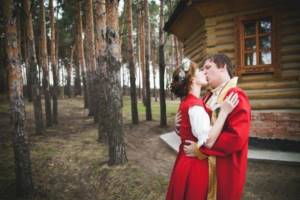
The beautiful form of the ceremony and sincere (often handwritten) vows in front of loved ones become more important than the stamp in the passport. Young people want to have the wedding of their dreams - in a picturesque place, with stylish decoration and with a professional ceremonial leader.
Some couples follow tradition and also have a wedding, while others simply stop by the church on their wedding day and ask the priest for his blessing.
Wedding feast - Wedding banquet.
The tradition of having a luxurious dinner after the wedding ceremony continues to live on. Previously, there were two feasts - in the groom's house and in the bride's house, today there is one celebration and often in a restaurant. Many families still pay the greatest attention to the holiday menu. It is impossible for the guests not to get drunk and full, or to find the dishes tasteless; this is very important for a Russian person.
Although modern wedding organizers often insist that the atmosphere of the holiday and its beauty are more important than the wedding table. Perhaps someday most couples will feel the same way.
Many couples today, as in the old days, receive the blessing of their parents with a loaf of bread before the feast. Although some people refuse this tradition.
Wedding rites and traditions among the ancient Slavs
A wedding ceremony is, to some extent, a mystical act, because just yesterday, complete strangers and strangers to each other, after a certain ceremony, suddenly become one family, a single whole.
Like most historical facts, we first learn about the life of the ancient Slavs from the Tale of Bygone Years. Nestor the chronicler wrote that it was during the wedding ceremony that the moral essence of a particular people is revealed.
The Polyans were considered peaceful people who revered the wedding ceremony as sacred, and peaceful life and mutual understanding in the family as an indispensable condition for future life together. Weddings at that time were not celebrated the way we celebrate them now. The bride was simply brought to the house of her future groom.
The Drevlyans did not have any specific moral principles, so it was customary among these people to steal brides. It’s just difficult to say whether this was a spontaneous decision or whether there were some specific agreements between the future husband and wife.
The Vyatichi, Northerners and Radimichi, as a rule, lived in forests. They usually did not enter into any marriages, but they organized special performances and games, at which representatives of several settlements (men) kidnapped future wives for themselves. It is also possible that the couples agreed in advance about who would be with whom. In addition, polygamy was accepted among these peoples.
Basically, all pagan wedding traditions and wedding rituals can be divided into two types:
- “leading” the wives, when the dowry was carried after the groom and the bride herself, which is somewhat reminiscent of a traditional Slavic marriage;
- "kidnapping" the bride, a crude option, of course, but it is still popular among many peoples even today.
With the development of society, the Slavic wedding ceremony also developed and expanded with new traditions. After a certain period of time, it acquired a certain meaning and order. Also, new deities began to appear, and the most cheerful and kind of them was Lado - the god of prosperity and love. The Slavs worshiped him and marriages were most often concluded on his day. Today, such a day can be considered Valentine's Day, when all couples strive to get married on this date.
Marriage in Rus' during Christianity
Kievan Rus adopted Christianity at the end of the 9th century in 988. New Christian wedding traditions entered the life of the common people with great difficulty. One of the most important innovations is the coverage of marriage in the church. True, it was not possible to completely instill this tradition in the Slavs of the Orthodox Church, and therefore this rule was not mandatory, and each nation continued to celebrate the wedding as best it could.
Many wedding customs and traditions were borrowed from other nations. So, for example, from Greece we borrowed the ritual of exchanging rings, as well as a veil (veil) on the bride’s head, wreaths, wedding candles, and at the end the ritual of joining the hands of the newlyweds.
It was customary to shower the ancient bride and groom with grain, money and hops, and our Russian loaf is just a reworked ancient Roman tradition.
Interesting fact: love and wedding did not intersect with each other. According to sociologists, marriage for love and mutual consent became possible only at the beginning of the 20th century, when women received some rights. In ancient times, a wedding was held not by a young man and a young girl, but by their families, who wanted to become related for mutual benefit. This was the custom among both the peasants and the nobility.
The time for a wedding directly depended on work in the field or on the farm, and in addition to this, there were also church prohibitions. For example, during Lent it was forbidden to get married, also on the eve of great Christian holidays, during Maslenitsa and Easter week, on the eve of Friday or Wednesday, and, of course, in May, since it was even believed among the people that those who marry in May, he will “toil all his life.”
Girls had to get married at the age of 12-13, but by this time they were fully trained housewives and knew all wedding customs. Even some dowry had already been saved up for the wedding. The most important thing for a young bride is to be able to embroider a gift with her own hands for her future husband, all the guests and his family.
Ancient Russian folk wedding rites and traditions
The newlyweds first met each other during their own wedding. Very rarely they were lucky, so it is no coincidence that Slavic women had so many “cries”. Folk wedding rituals and traditions among the Slavs consisted of several stages:
- Matchmaking;
- Bride"
- Hand-shaking (collusion) - determining and setting the date of the wedding ceremony, calculating expenses, etc.;
- Howling is the cry of a young bride in her parents’ house about the future separation and upcoming changes. At this stage the mother was undoing her daughter's braid;
- Bachelorette party - the bride still continues to cry, her girlfriends help her finish the gift for the groom and his family, and after that the girl is washed in the bathhouse;
- Bride ransom;
- Wedding;
- Wedding feast.
In Ancient Rus', each wedding stage corresponded to a number of traditions that were performed by certain people. So, for example, the matchmaker had to remove the girl’s wreath from the bride, twist her hair and put a kika (women’s headdress) on her head. On top of which they also put a blanket. When a father gave his daughter to her husband, he would lightly beat her with a whip so that her husband would obey, and then pass the whip to her future husband.
The wedding feast was a test not only for the guests and their stomachs, but also for the newlyweds themselves. It lasted, as a rule, three whole days. There was no place at the table for the newlyweds, so they first accepted congratulations from all their relatives, and then went to a wedding bed specially arranged for them in a hay barn with amulets and symbols.
On the second day of the wedding, the newlyweds were already seated at the table, and after the feast they were taken to the bathhouse, the matchmaker showed everyone the bride’s shirt, which was supposed to have blood on it as confirmation of her innocence. On the third day of the wedding, the young newly-made wife demonstrated her household skills to everyone, and the guests only occasionally helped her.
Wedding ceremonies and traditions of Russia today
A modern wedding combines not only the traditions of the Slavs, but also modern rituals associated with the realities and possibilities of our time, as well as colorful wedding rituals of other countries. Traditional moments of a modern Russian wedding:
- Matchmaking;
- Bride ransom;
- Registration of marriage at the registry office;
- Wedding in a church (at the request of the newlyweds);
- A trip or walk through the colorful places of the city with a photographer;
- A wedding banquet containing some traditions (removing the veil and putting a scarf on the head, dancing of the young wife and unmarried girls, throwing the wedding bouquet, etc.).
The bride price is of particular importance, since it is this tradition that basically sets the rhythm for the entire holiday, since it should be interesting, fun and memorable. Depending on the imagination of the organizer, it is held in a variety of styles: romantic, pirate, fairy tale, etc.
A wedding is one of the events in our lives that forever remains in the memory of the young, but traditions in ancient times were aimed at protecting the future family from various troubles and the evil eye.
The wedding night.
Despite the fact that the essence of this event has changed greatly, there are still couples who still attach importance to it. Romantic atmosphere, beautiful linen, music - young people strive to make this night extraordinary. True, there are those who claim that they slept soundly throughout their wedding night, because a wedding is still a tiring event.
Be that as it may, one thing is good: now the groom’s relatives do not check in the morning whether the bride was a girl before the wedding. Personal remains personal – that’s right.

How to write a term paper on speech therapy
07.09.2010 200813
These guidelines are compiled to help students gain an understanding of the content and structure of coursework in speech therapy.
Logopedia of pedagogical science that studies anomalies of speech development with normal hearing, explores the manifestations, nature and mechanisms of speech disorders, develops the scientific basis for overcoming and preventing them means of special training and education.
The subject of speech therapy as a science is speech disorders and the process of training and education of persons with speech disorders.
The object of study is a person suffering from a speech disorder.
The main task of speech therapy as a science is the study, prevention and elimination of various types of speech disorders.
Coursework in speech therapy is a student's scientific and experimental research. This type of educational activity, provided for by the educational and professional program and curriculum, contributes to the acquisition of skills in working with literature, analyzing and summarizing literary sources in order to determine the range of insufficiently studied problems, determining the content and methods of experimental research, processing skills and qualitative analysis of the results obtained. The need to complete coursework in speech therapy is due to the updating of knowledge concerning the content, organization, principles, methods and techniques of speech therapy work.
As a rule, during their studies, students must write two term papers - theoretical and practical.
The first course work should be devoted to the analysis and synthesis of general and specialized literature on the chosen topic. Based on this analysis, it is necessary to justify and develop a method of ascertaining (diagnostic) experiment.
In the second course work, it is necessary to provide an analysis of the results obtained during the ascertaining experiment, as well as determine the directions and content of speech therapy work, and select adequate methods and techniques of correction.
So, let’s present the general requirements for the content and design of coursework in speech therapy.
The initial and most important stage of working on a course project is the choice of a topic, which is either proposed by the supervisor or chosen by the student independently from a list of topics that are consistent with the areas of scientific research of the department.
Each topic can be modified, considered in different aspects, but taking into account a theoretical and practical approach. Having chosen a topic, the student needs to think through in detail its specific content, areas of work, practical material, etc., which should be reflected both in the formulation of the topic and in the further construction of the study. It should be recalled that the chosen topic may not only have a purely theoretical orientation, for example: “Dysarthria. Characteristics of the defect”, “Classification of dysgraphia”, but also take into account the practical significance of the problem under consideration, for example: “Speech therapy work on speech correction for dysarthria”. It should also be taken into account that when formulating a topic, excessive detail should be avoided, for example: “Formation of prosodic components of speech in preschoolers of the sixth year of life attending a preschool institution for children with severe speech impairments.”
The course work includes such mandatory parts as: introduction, three chapters, conclusion, bibliography and appendix.
The text of the term paper begins with the title page . An example of its design can be seen here.
Then the content of the work is given, in which the names of chapters, paragraphs, and sections are formulated in strict accordance with the content of the thesis. An example of its design can be seen here.
In the text, each subsequent chapter and paragraph begins on a new page. At the end of each chapter, the materials are summarized and conclusions are formulated.
The introduction reveals the relevance of the problem under consideration in general and the topic being studied in particular; the problem, subject, object, and purpose of the study are defined. In accordance with the goal and hypothesis, objectives and a set of research methods aimed at achieving the objectives must be defined.
The relevance of the topic lies in reflecting the current level of pedagogical science and practice, meeting the requirements of novelty and usefulness.
When defining the research problem, it is important to indicate what practical tasks it will help to implement in training and educating people with speech pathology.
The object of research is understood as certain aspects of pedagogical reality, perceived through a system of theoretical and practical knowledge. The ultimate goal of any research is to improve this object.
The subject of research is some part, property, element of an object, i.e. the subject of research always indicates a specific aspect of the object that is to be studied and about which the researcher wants to gain new knowledge. An object is a part of an object.
You can give an example of the formulation of the object, subject and problem of research:
– The object of the study is the speech activity of preschool children with phonetic-phonemic speech disorders.
– The subject of the study is the features of intonation speech of children with phonetic-phonemic speech disorders.
– The research problem is to determine effective directions for speech therapy work on the formation of intonation expressiveness of speech in the system of correctional intervention.
The purpose of the study contributes to the specification of the object being studied. The goal of any research is to solve a specific problem. The goal is specified in tasks taking into account the subject of research.
The research objectives are formulated in a certain sequence, which determines the logic of the research. The research objectives are set on the basis of a theoretical analysis of the problem and an assessment of the state of its solution in practice.
The first chapter is an analysis of literary sources, which examines the state of this problem in historical and modern aspects, and presents the most important theoretical principles that formed the basis of the study.
When writing the first chapter, you should pay attention to the fact that the text of the course work must be written in a scientific style. When presenting scientific material, it is necessary to comply with the following requirements:
– Specificity – a review of only those sources that are necessary to disclose only a given topic or solve only a given problem;
– Clarity – which is characterized by semantic coherence and integrity of individual parts of the text;
– Logicality – which provides for a certain structure of presentation of the material;
– Reasoning – evidence of thoughts (why this and not otherwise);
– Precision of wording, excluding ambiguous interpretation of the authors’ statements.
A literary review of the state of the problem being studied should not be reduced to a consistent presentation of literary sources. It should present a generalized description of the literature: highlight the main directions (currents, concepts, points of view), analyze in detail and evaluate the most fundamental works of representatives of these directions.
When writing a work, the student must correctly use literary materials, make references to the authors and sources from which the results of scientific research are borrowed. Failure to provide required references will reduce your coursework grade.
As a rule, in coursework on speech therapy, references to literary sources are formatted as follows: the number of the cited source in the general list of references is placed in square brackets. For example: General speech underdevelopment is a speech pathology in which there is a persistent lag in the formation of all components of the language system: phonetics, vocabulary and grammar [17].
When using quotations, in square brackets, in addition to indicating the source number, the page number from which this excerpt is taken is indicated, for example: Speech rhythm is based on a physiological and intellectual basis, since, firstly, it is directly related to the rhythm of breathing. Secondly, being an element that performs a communicative function, “correlates with meaning, i.e. controlled intellectually” [23, P.40].
However, course work should not be of a purely abstract nature, so you should not abuse the unreasonable abundance of citations. Quoting should be logically justified, convincing and used only when really necessary.
In the second chapter , devoted to experimental research, the organization should be described and the program of the ascertaining experiment should be presented. The survey methodology, as a rule, consists of a description of several series of tasks, with detailed instructions, visual and lexical material, the procedure for completing tasks by experiment participants, and scoring criteria. This chapter also provides a qualitative and quantitative analysis of the results obtained.
When analyzing the results of an experiment, it is necessary to use a scoring system. Examples of various criteria for quantitative and qualitative assessment are presented in the following works:
– Glukhov V.P. Formation of coherent speech in preschool children with general speech underdevelopment. - M.: Arkti, 2002. - 144 p.
– Fotekova T.A. Test methodology for diagnosing oral speech of primary schoolchildren. - M.: Arkti, 2000. - 56 p.
– Levchenko I.Yu. Pathopsychology: Theory and practice. - M.: Academy, 2000. - 232 p.
In order to visually present the results obtained during the experimental study, it is recommended to use tables, graphs, diagrams, etc. Histograms can be used in a variety of ways - columnar, cylindrical, planar, volumetric, etc. An example of the design of tables, figures, and histograms can be found here.
The third chapter provides a rationale for the proposed methods and techniques and reveals the content of the main stages of correctional work.
The conclusion contains a summary of the material presented and the main conclusions formulated by the author.
The bibliography must contain at least 25 sources. The list includes bibliographic information about the sources used in preparing the work. An example of its design can be seen here.
In the application you can present bulky tables or illustrations, examination protocols, observation records, products of activity (drawings, written works of children), notes from speech therapy classes, etc.
The volume of one course work must be at least 30 pages of typewritten text.
In general, coursework in speech therapy is the basis for a future thesis, in which the study of the begun problem can be continued, but from the standpoint of a different approach or a comparative analysis of the disorders being studied in different age categories of people with different types of speech disorders.
The content and format of theses in speech therapy can be found here.
Literature:
1. How to write a term paper on speech therapy: Methodological recommendations. Educational and methodological manual / Comp. Artemova E.E., Tishina L.A. / Ed. Orlova O.S. – M.: MGOPU, 2008. – 35 p.
2. Research work of students in the system of higher professional pedagogical education (specialty 031800 - Speech therapy). Methodological recommendations for completing the thesis / Compiled by. L.V. Lopatina, V.I. Lipakova, G.G. Golubeva. - St. Petersburg: Publishing house of the Russian State Pedagogical University named after. A. I. Herzen, 2002. - 140 p.
Mother-in-law's pancakes - Second wedding day.
On the wedding day, the main celebration took place at the groom's house. And on the second day, the guests went to the bride’s house, where the mother-in-law was supposed to meet her son-in-law with pancakes. Today, weddings often do not take place in just one day. The celebration continues on the second day, in a more informal setting. In the summer they often organize field trips.
Over the hundreds of years of its existence, the wedding celebration has, of course, changed a lot, but many of its elements are still preserved. The power of meaningful traditions is very great; through them we feel a connection with past generations.
Weddings in Rus': how were they held?
In accordance with the recommendations of Domostroy, the groom had to arrive at the bride’s house on his own argamak. Simpler grooms, as a rule, rode in decorated sleighs. All levels of society sought to make the wedding train larger, to decorate the horses and sleighs with ribbons, flowers, multi-colored valances and embroidered towels. A mandatory attribute were bells and bells, which warned in advance that the groom and his retinue were approaching the bride’s house. The groom's parents usually did not go to the bride's house; from that moment on, their functions for the period of wedding celebrations were taken over by the imprisoned father and mother.
The fact that the groom could leave for the bride was usually notified by a messenger sent by the future father-in-law. These duties could be performed by a friend or semi-friend. The first to go to the yard of the bride's father were the groom's friends, groomsmen or thousand, who had to pay a symbolic ransom for the right to enter the groom's house. Usually, ransoms for the right of the groom to enter the house and for the bride were paid not in money, but in small gifts, sweets, and those who wished could pour a glass. Those who arrived were seated at the table. Only the groom's mother or his relative went directly to the bride, who had to make sure that she was ready to go out.
Until the end of the 18th century, the betrothal was first held in the bride's house. After it, the young people could kiss in public for the first time. Then the newlyweds were prepared for the wedding; a mandatory element was combing the bride's hair and braiding her hair. At this time, the guests were presented with small gifts (usually a scarf) and a ritual treat from the bride's parents: cheese, bread and wine, after which a short feast could follow. At the same time as messengers from the bride's parents, bread, cheese and scarves were sent to the groom's parents and all those invited to the wedding who were not present at the betrothal in the bride's house.
When the newlyweds were brought out to the guests, they were sprinkled with hops and grain, and the friend or tysyatsky asked the bride’s parents: “Bless your children to go to the wedding.” Having received the blessing, the groom led the bride out of the house by the hand and helped her into the sleigh. He himself had to go to church in his sleigh or on horseback. The already united wedding train was leaving for the church. In a number of places, the parents of the newlyweds did not go to church; in this case, they and some of the guests on their side, after the young couple’s departure, went to the groom’s house.
After the wedding, the young husband sat in the sleigh with his wife, but if he was riding, his representative or his imprisoned mother sat in his place with the young woman. The groom's parents greeted the newlyweds in front of the wide open gate to the courtyard, sometimes even dismantling part of the fence to make the passage wider. An obligatory element of the meeting was a loaf of bread, which the young people bit into, trying to “grab” a larger piece. In a number of places, in addition to the loaf, a sieve was taken out to the newlyweds, as a symbol that the newlyweds would escape troubles, leaving like water through a sieve.
When the newlyweds entered the courtyard, they were sprinkled with grain and hops. Then the newlyweds were taken to a separate room, where a small treat was prepared for them, usually symbolic, with wishes for a happy life, wealth and numerous offspring. In the north-west of Rus', they used fish pie and milk with cranberries for this - “so that there would be a lot of children, like fish in a river, and they would be strong - blood and milk.”
The newlyweds had the opportunity to rest a little before the wedding feast, but the main thing was that at this time the young woman was changing clothes and combing her hair, who was now entitled to a woman’s hairstyle and headdress. In addition, in some places, young people went to the wedding in festive, but already worn, clothes, and changed into everything new upon arrival at the groom’s house, thereby emphasizing the beginning of a new life for themselves.
At this time, a small “buffet” was arranged for the guests - they treated them to wine and snacks, and also showed off the bride’s dowry, which was usually hung and displayed in the room where the wedding table was set. Traditionally, the wedding table was placed in a “T” shape, so that the newlyweds sat under the icons. Before the newlyweds, a loaf of bread and one or two more wedding ritual dishes, depending on the region, were always placed on the table; these could be pancakes, special cookies (brushwood), cheese, or pie.
According to tradition, on the first day the general wedding feast did not last long. After several changes of dishes, the newlywed stood up and bowed to those gathered, and the friend or thousand on his behalf invited everyone to continue the wedding feast the next day. If the addresses were personal to each of the guests, then the newlyweds accompanied each of them with a bow.
After this, the young people were taken to the room where the marriage bed was arranged. Usually the feast continued at this time, but those who wished could leave it without causing offense to the hosts. The general joy subsided, as both relatives and guests waited for news that the young husband had coped with the responsibility assigned to him by nature, and the young wife turned out to be blameless.
There was no single ritual for the first wedding night; they differed markedly in different regions. Somewhere the young people were not disturbed until they themselves let it be known that everything had worked out for them. In a number of places they were periodically visited in order, if necessary, to suggest what and how to do. Usually these functions were assigned to the matchmaker.
Domostroy gives interesting recommendations in this regard. After the young people were undressed, put to bed and left alone, “the thousand and the traveler and the friend and the senior matchmaker will enter the father-in-law’s room and say here: “God has granted: after the wedding, your children have gone to rest in good health, and now they are enjoying themselves.” And two bed-maids sit relentlessly at the door, and when the time comes for the newlywed, after lying down and getting to know him, he calls the bed-maid and orders him to call the nearby noblewoman, and he, going behind the curtain and washing himself with water, throws on a robe and a fur coat. And then the newlywed will go with a noblewoman or two, and there they will wash her, and soak both shirts in basins. And the newlywed will also throw on a robe and a fur coat and order to call a friend to her, and the newlywed will sit on the large bed, while the newlywed will sit on a down jacket behind the curtain.
When the friend comes, they will send him to his father and mother to tell him that, God willing, everything is in order. And they will send a matchmaker, and then the thousand or one of the close relatives will come to the newlywed, and the mother-in-law or the noblewomen and relatives will come to the newlywed and bring food in their hands, crumbled poultry jelly with plums and lemons and cucumbers. The newlywed is fed by the thousand, and the newlywed is fed by the mother-in-law and the noblewomen behind the curtain. Meanwhile, the friend will be sent to his mother-in-law and father-in-law, and he, having arrived, says, calling by his full name: “The newlywed ordered to tell you: by God’s mercy and your parental grant and preservation, we, God willing, managed, and on that I beat your grant with my forehead.” " And then the father-in-law will kiss his friend, give him a cup or a ladle, and the mother-in-law will give him a scarf. And from now on, fun and celebration begin in both yards.”
In the morning, the newlyweds traditionally went to the bathhouse together and then returned to the wedding feast. It was on this day that they were given gifts; in return, they gave “gifts” to relatives, guests and wedding officials. In many places, rituals were held to test the work skills of young people, while guests presented them with money for good work, but also interfered with it in every possible way, which created additional fun. It was on the second day that the vodka became “bitter”, and the newlyweds had to kiss tirelessly to sweeten it.
Usually at peasant weddings, all celebrations ended on this day. At rich weddings, feasts could continue for several more days, but without ritual actions, and often without the newlyweds, who could begin to pay visits to relatives, visit churches or holy places.
The simplification of wedding rituals began in the 18th century. At first, weddings in the imperial family began to be held in the European style, then this was followed by the highest nobility, nobles and merchants. Only in the villages, even in the first years of Soviet power, weddings took place in compliance with many old rituals, and where churches were preserved, with weddings.
These days, some half-forgotten wedding rituals have begun to make a comeback. It will no longer be possible to revive them in full, and, apparently, this is not necessary, since life has changed significantly. But you must admit that there was something in the old rituals that not only made it possible to make a wedding memorable, but also to fill it with deep meaning, turning it into one of the main life events.
Tags: Rus', traditions, rituals, wedding, history






